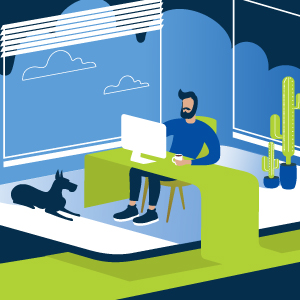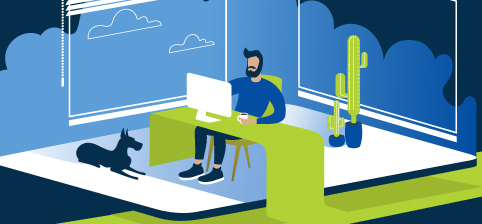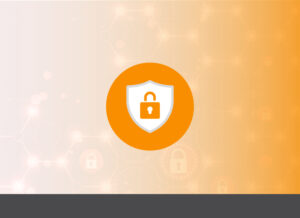In the wake of statewide stay-at-home orders triggered by the COVID-19 pandemic across the country, businesses have had to pivot to telework operations practically overnight. This effort, considered a challenge for any business, was especially difficult for government agencies—in 2019, just 19 percent of local government agencies, and less than half of all states, had any telework infrastructure set up.
 Agencies have had to put in place stopgap measures to set up systems, establish policies and procedures, and acquire or adjust the technology needed to enable employees to work from home efficiently and securely.
Agencies have had to put in place stopgap measures to set up systems, establish policies and procedures, and acquire or adjust the technology needed to enable employees to work from home efficiently and securely.
While some states are starting to reopen businesses, the timeline for a nationwide return to work remains unknown, and organizations need to be prepared for prolonged or renewed wide-scale teleworking. Agencies should take this opportunity to assess their current telework setup and consider how it might look in the future—what changes should be made to optimize systems, ensure reliability, and create a scalable and sustainable solution?
Assess the Current Infrastructure
There are several ways to gauge the capabilities of remote work systems, but starting by asking some high-level questions can help frame the approach in a more holistic manner and provide insight to larger, systemic issues:
- Do employees have access to the infrastructure, processes, and solutions they need to telework efficiently?
- Are there any roadblocks in place that require workarounds? How can those be removed?
- Is the agency’s work actually getting done, and if not, why?
- Are employees able to completely replicate their use of the agency’s digital infrastructure from home? Are they able to use essential tools on all of their devices?
- Does the agency’s current solution mesh with the technology and systems employees are using at home and on the road?
- Is the current telework setup as secure as possible?
- If the agency had to telework a year from now, would the current solution still be viable?
Answering these questions will identify the pain points employees might be experiencing in this makeshift telework environment and encourages a forward-thinking framework to ensure that the optimal solution is one that will work both today and in a year from now.
Address Technical Problems
The assessment likely revealed some technical incongruities that make remote work more challenging—these concerns can generally be resolved with the adoption of enterprise-level software and tools.
One of the quickest ways many organizations made the overnight switch to teleworking was relying on the use of a public cloud provider. While these solutions are a common approach to data management on a small scale, many larger agencies and organizations are probably discovering that they do not scale easily—or if they do, it comes at a steep cost. Seeking out an enterprise cloud solution that is built to handle large amounts of data and many users will benefit agencies both now and in the future, as many of these solutions can grow with the organization and provide an impressive array of data management tools.
Consider Systemic Changes
During the assessment, it’s possible that a few nagging systemic or technical issues bubbled up again and again. Now is a great time to address those concerns during the larger process of adjusting the agency’s digital infrastructure. Identifying, prototyping, and testing solutions to create a more secure, productive, and human-centric environment will address systemic issues. This concept can take the agency’s teleworking approach from an emergency option to an innovative and forward-thinking environment, and maybe even an employee recruiting and retention tool.
The pandemic has caused a seismic shift in how business is conducted, and the government and industries are working together to help organizations bounce back stronger than before. The combination of emergency and stimulus funding, as well as vendor partners focused on helping organizations assess and optimize their telework infrastructure, have made this an ideal time to create and scale end user computing environments for a solution that works both now and in the future.
For more information about Nutanix work from home solutions, contact us at nutanix@carahsoft.com or sign up for our free 30-day, unlimited user trial of Nutanix’s Desktop as a Serice (DaaS) – in this hassle-free test drive – and get started working from anywhere in under 1 hour.







